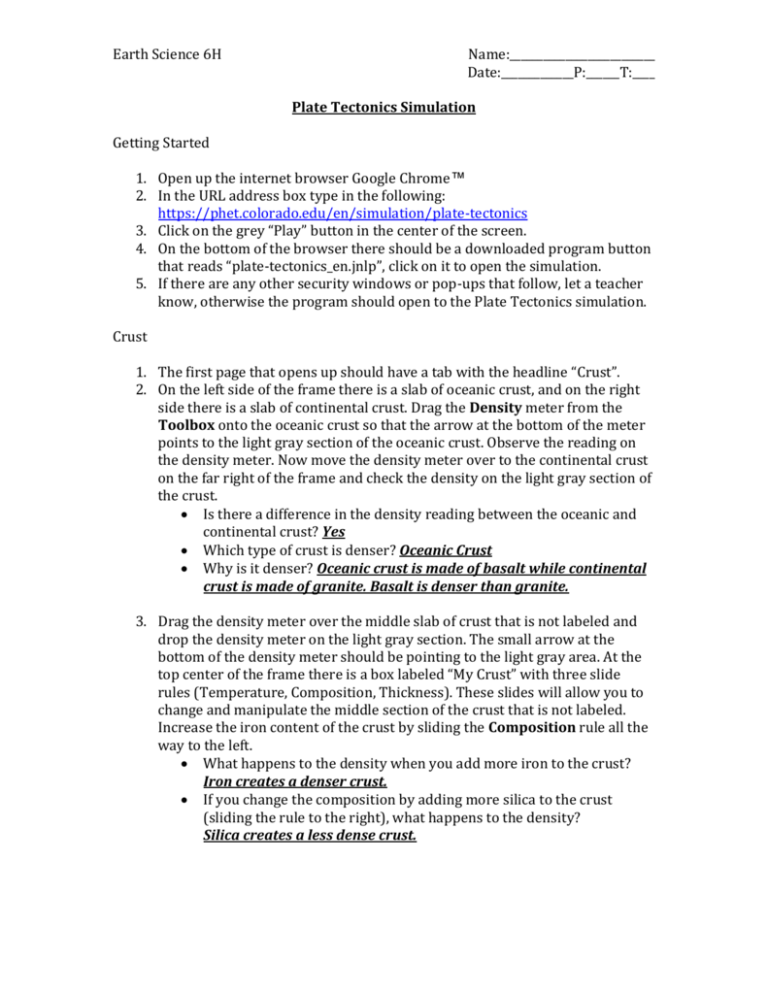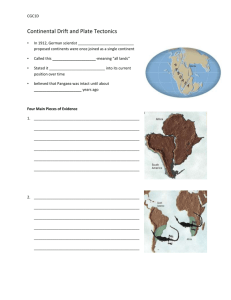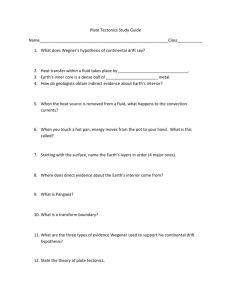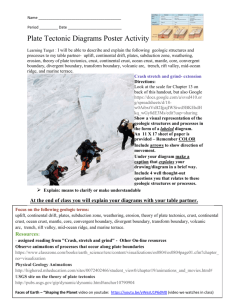Plate Tectonics Lab Answer Key
advertisement

Earth Science 6H Name:__________________________ Date:_____________P:______T:____ Plate Tectonics Simulation Getting Started 1. Open up the internet browser Google Chrome™ 2. In the URL address box type in the following: https://phet.colorado.edu/en/simulation/plate-tectonics 3. Click on the grey “Play” button in the center of the screen. 4. On the bottom of the browser there should be a downloaded program button that reads “plate-tectonics_en.jnlp”, click on it to open the simulation. 5. If there are any other security windows or pop-ups that follow, let a teacher know, otherwise the program should open to the Plate Tectonics simulation. Crust 1. The first page that opens up should have a tab with the headline “Crust”. 2. On the left side of the frame there is a slab of oceanic crust, and on the right side there is a slab of continental crust. Drag the Density meter from the Toolbox onto the oceanic crust so that the arrow at the bottom of the meter points to the light gray section of the oceanic crust. Observe the reading on the density meter. Now move the density meter over to the continental crust on the far right of the frame and check the density on the light gray section of the crust. Is there a difference in the density reading between the oceanic and continental crust? Yes Which type of crust is denser? Oceanic Crust Why is it denser? Oceanic crust is made of basalt while continental crust is made of granite. Basalt is denser than granite. 3. Drag the density meter over the middle slab of crust that is not labeled and drop the density meter on the light gray section. The small arrow at the bottom of the density meter should be pointing to the light gray area. At the top center of the frame there is a box labeled “My Crust” with three slide rules (Temperature, Composition, Thickness). These slides will allow you to change and manipulate the middle section of the crust that is not labeled. Increase the iron content of the crust by sliding the Composition rule all the way to the left. What happens to the density when you add more iron to the crust? Iron creates a denser crust. If you change the composition by adding more silica to the crust (sliding the rule to the right), what happens to the density? Silica creates a less dense crust. Earth Science 6H Name:__________________________ Date:_____________P:______T:____ Click the yellow “Reset All” button at the bottom. Drag and drop the density meter on the middle slab of crust again. If you add heat to the crust by sliding the Temperature rule to the right, what happens to the density of the material? Higher temperature means lower density. What happens to the density of the material if you make the crust cooler by taking away heat? (Slide Temperature rule to the left) Cooler temperatures means higher density. Plate Motion 1. Click on the second tab at the top of the frame labeled “Plate Motion”. 2. In the bottom right hand corner of the frame there should be a box with three different types of crust (Continental, Young Oceanic, Old Oceanic). Click on the Continental crust and drag it over the dashed outline of the crust on the left hand side. Drop the continental crust when the dashed outline turns yellow/green. 3. Drag and drop the Old Oceanic crust on the right hand side of the crust. 4. In the box labeled “View”, check the option “Show Seawater” by clicking on the box next to the option. 5. Click and hold the green arrow until the plates stop moving and write down what you observe happening: The oceanic crust is sliding under the continental crust and creates a subduction zone. There is slab pull at the subduction zone because gravity pulls the oceanic crust down into the mantle. As the oceanic crust goes under, it starts to melt and creates magma that rises to the surface and exits through volcanic mountains. What type of plate boundary is this? Convergent What stress force is being applied? Compression What do you see forming at these boundaries? Volcanic mountains, subduction zones 6. Click the yellow “Reset All” button. 7. Drag and drop Old Oceanic crust on the left hand side of the plate boundary. 8. Drag and drop New Oceanic crust on the right hand side of the plate boundary. 9. Check the box labeled “Show Seawater”. 10. Click and hold the green arrow until the plates stop moving. What forms at this boundary? Subduction zones, underwater volcanoes. How many years did it take for this to form? 50 million years If both plates were made of oceanic crust, how is it possible for one of the plates to slide under the other? Explain. Old oceanic crust is denser than younger, newer oceanic crust because old oceanic crust has had a longer period of time underwater so the weight of the ocean water has compressed the crust and has become denser. Earth Science 6H Name:__________________________ Date:_____________P:______T:____ 11. Click the yellow “Reset All” button. 12. Drag and drop Continental crust on the left hand side of the boundary. 13. Drag and drop Continental crust on the right hand side of the boundary. 14. Click and hold the green arrow until the plates no longer move. What forms at this boundary? Folded mountains. Where on our planet can we see this happening? (Hint: Think Mt. Everest) Himalayas, Glacier Lake Why are there no subduction zones at this boundary? Continental crust converging causes mountains and not subduction because the densities are equal and the only way for the plates to move is up. 15. Click the yellow “Reset All” button. 16. Drag and drop Continental crust on the left hand side of the boundary. 17. Drag and drop Continental crust on the right hand side of the boundary. 18. Check the box next to the label “Show Seawater”. 19. Click and hold the red arrow until the plates no longer move. What type of plate boundary is this? Divergent What stress force is being applied? Tension What is created at this type of boundary? Mid-ocean ridges, faultblock mountains. Where on our planet can we find this type of boundary? (Hint: Think oceans) Mid-Atlantic Ridge, Tetons in Wyoming Name and describe the process that is occurring underneath the crust that allows new crust to form. Convection occurs when tectonic plates are pulled into the mantle and melt due to high pressure and temperatures. Magma then rises due to lower densities and comes out of the mid-ocean ridges. The crust then cools and hardens and starts to sink into the mantle to start the cycle again. 20. Click the yellow “Reset All” button. 21. Drag and drop Continental crust on the left hand side of the boundary. 22. Drag and drop Continental crust on the right hand side of the boundary. 23. Click and drag the blue arrow until the plates no longer move. What type of boundary is this? Transform Movement of the plates at this boundary causes what type of natural phenomenon? Earthquakes Where on our planet can you find this type of boundary? (Hint: Think faults) San Andreas Fault








